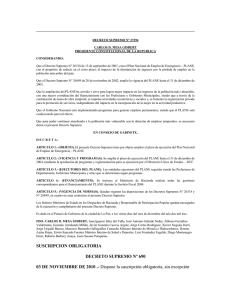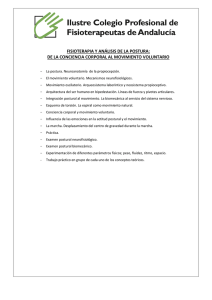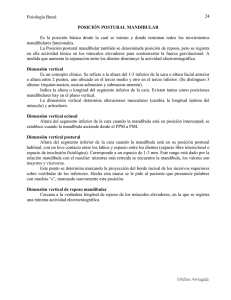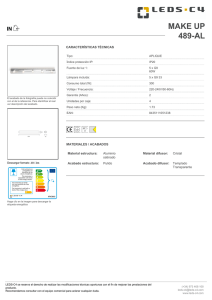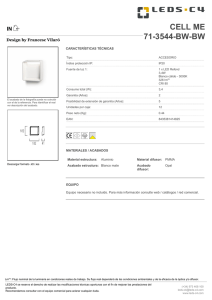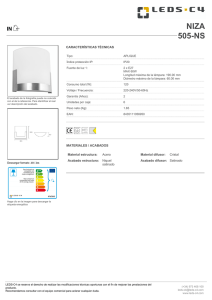INCLINACIÓN DEL PLANO OCLUSAL EN NIÑOS ENTRE NUEVE Y
Anuncio
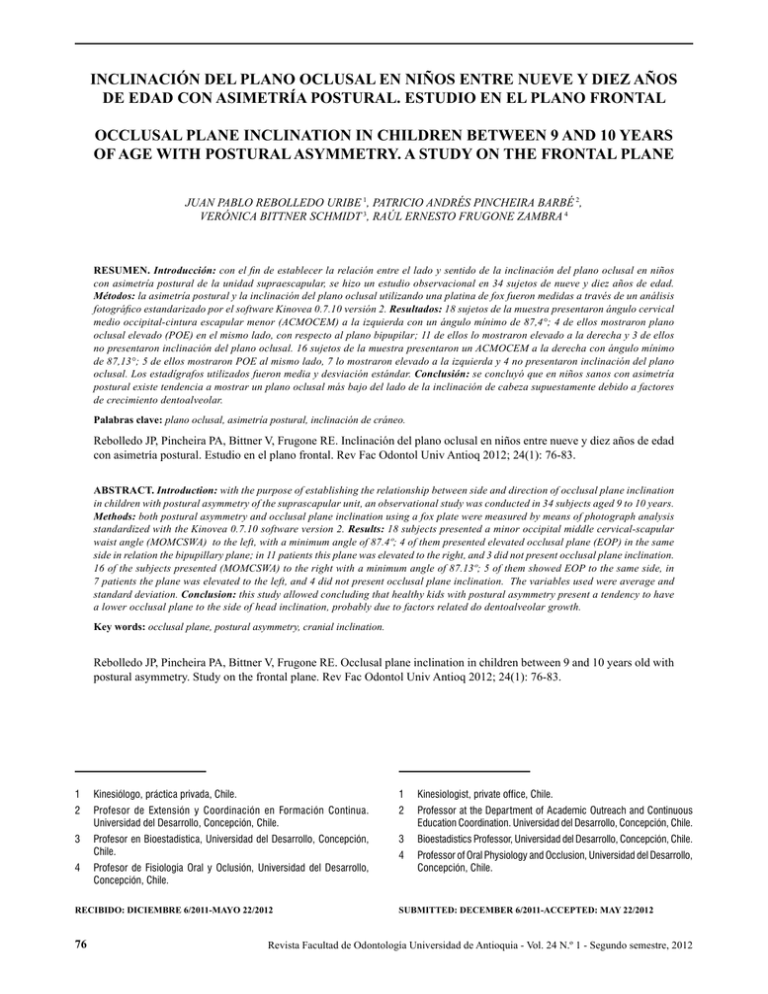
INCLINACIÓN DEL PLANO OCLUSAL EN NIÑOS ENTRE NUEVE Y DIEZ AÑOS DE EDAD CON ASIMETRÍA POSTURAL. ESTUDIO EN EL PLANO FRONTAL OCCLUSAL PLANE INCLINATION IN CHILDREN BETWEEN 9 AND 10 YEARS OF AGE WITH POSTURAL ASYMMETRY. A STUDY ON THE FRONTAL PLANE JUAN PABLO REBOLLEDO URIBE 1, PATRICIO ANDRÉS PINCHEIRA BARBÉ 2, VERÓNICA BITTNER SCHMIDT 3, RAÚL ERNESTO FRUGONE ZAMBRA 4 RESUMEN. Introducción: con el fin de establecer la relación entre el lado y sentido de la inclinación del plano oclusal en niños con asimetría postural de la unidad supraescapular, se hizo un estudio observacional en 34 sujetos de nueve y diez años de edad. Métodos: la asimetría postural y la inclinación del plano oclusal utilizando una platina de fox fueron medidas a través de un análisis fotográfico estandarizado por el software Kinovea 0.7.10 versión 2. Resultados: 18 sujetos de la muestra presentaron ángulo cervical medio occipital-cintura escapular menor (ACMOCEM) a la izquierda con un ángulo mínimo de 87,4°; 4 de ellos mostraron plano oclusal elevado (POE) en el mismo lado, con respecto al plano bipupilar; 11 de ellos lo mostraron elevado a la derecha y 3 de ellos no presentaron inclinación del plano oclusal. 16 sujetos de la muestra presentaron un ACMOCEM a la derecha con ángulo mínimo de 87,13°; 5 de ellos mostraron POE al mismo lado, 7 lo mostraron elevado a la izquierda y 4 no presentaron inclinación del plano oclusal. Los estadígrafos utilizados fueron media y desviación estándar. Conclusión: se concluyó que en niños sanos con asimetría postural existe tendencia a mostrar un plano oclusal más bajo del lado de la inclinación de cabeza supuestamente debido a factores de crecimiento dentoalveolar. Palabras clave: plano oclusal, asimetría postural, inclinación de cráneo. Rebolledo JP, Pincheira PA, Bittner V, Frugone RE. Inclinación del plano oclusal en niños entre nueve y diez años de edad con asimetría postural. Estudio en el plano frontal. Rev Fac Odontol Univ Antioq 2012; 24(1): 76-83. ABSTRACT. Introduction: with the purpose of establishing the relationship between side and direction of occlusal plane inclination in children with postural asymmetry of the suprascapular unit, an observational study was conducted in 34 subjects aged 9 to 10 years. Methods: both postural asymmetry and occlusal plane inclination using a fox plate were measured by means of photograph analysis standardized with the Kinovea 0.7.10 software version 2. Results: 18 subjects presented a minor occipital middle cervical-scapular waist angle (MOMCSWA) to the left, with a minimum angle of 87.4º; 4 of them presented elevated occlusal plane (EOP) in the same side in relation the bipupillary plane; in 11 patients this plane was elevated to the right, and 3 did not present occlusal plane inclination. 16 of the subjects presented (MOMCSWA) to the right with a minimum angle of 87.13º; 5 of them showed EOP to the same side, in 7 patients the plane was elevated to the left, and 4 did not present occlusal plane inclination. The variables used were average and standard deviation. Conclusion: this study allowed concluding that healthy kids with postural asymmetry present a tendency to have a lower occlusal plane to the side of head inclination, probably due to factors related do dentoalveolar growth. Key words: occlusal plane, postural asymmetry, cranial inclination. Rebolledo JP, Pincheira PA, Bittner V, Frugone RE. Occlusal plane inclination in children between 9 and 10 years old with postural asymmetry. Study on the frontal plane. Rev Fac Odontol Univ Antioq 2012; 24(1): 76-83. 1 1 Kinesiólogo, práctica privada, Chile. Kinesiologist, private office, Chile. 2 Profesor de Extensión y Coordinación en Formación Continua. Universidad del Desarrollo, Concepción, Chile. 2 Professor at the Department of Academic Outreach and Continuous Education Coordination. Universidad del Desarrollo, Concepción, Chile. 3 Profesor en Bioestadística, Universidad del Desarrollo, Concepción, Chile. 3 Bioestadistics Professor, Universidad del Desarrollo, Concepción, Chile. 4 Profesor de Fisiología Oral y Oclusión, Universidad del Desarrollo, Concepción, Chile. RECIBIDO: DICIEMBRE 6/2011-MAYO 22/2012 76 4 Professor of Oral Physiology and Occlusion, Universidad del Desarrollo, Concepción, Chile. SUBMITTED: DECEMBER 6/2011-ACCEPTED: MAY 22/2012 Revista Facultad de Odontología Universidad de Antioquia - Vol. 24 N.º 1 - Segundo semestre, 2012 OCCLUSAL PLANE INCLINATION IN CHILDREN BETWEEN 9 AND 10 YEARS OF AGE WITH POSTURAL ASYMMETRY. A STUDY ON THE FRONTAL PLANE INTRODUCCIÓN INTRODUCTION La relación entre asimetría postural e inclinación del plano oclusal aún es una pregunta no resuelta a pesar de que hay variados estudios en temas afines. The relationship between postural asymmetry and occlusal plane inclination is still an unanswered question although several studies on similar topics have been conducted. Existe evidencia de la relación entre maloclusión y sobreactivación de musculatura postural. Esto se observa al equilibrar la oclusión ya que se produce una reducción significativa de las tasas de activación muscular medidas con electromiografía de superficie.1 Otro estudio sugiere la repercusión de la oclusión dental en la propiocepción y estabilización visual,2 por consiguiente se podría afectar el control de la postura y el equilibrio de la misma. Con relación a la asimetría postural e inclinación del plano oclusal existen muchas conjeturas. Considerando la íntima relación entre la postura y el sistema estomatognático3 y a su vez entre la forma y la función, se podría inferir que la inclinación del plano oclusal en el plano frontal podría variar debido a los cambios de la biomecánica general del componente supraescapular. Rocabado, en 1979, dijo: [...] en posición de inclinación lateral de cabeza y cuello, la mandíbula es desplazada hacia el lado contrario del movimiento por efecto compensatorio mandibular. Ello determina contactos en las cúspides fundamentales del lado contra lateral del movimiento y sólo contactos tenues en el lado homo lateral [sic].4 Por otra parte, del análisis sobre crecimiento y desarrollo en función de la rehabilitación neurooclusal5 y de la teoría de las matrices funcionales6 se puede explicar cómo la inclinación del plano oclusal en el espacio responde a estímulos funcionales donde el efecto de las matrices genera cambios estructurales en el hueso basal y en el componente dentoalveolar. Estos cambios se expresan fundamentalmente en un crecimiento vertical (incremento o reabsorción) del componente basal.5 Por ende, tanto las asimetrías posturales y funcionales como las parafunciones, que desarrolle un sujeto, podrían generar modificaciones estructurales con manifestación en la altura del hueso basal; un estímulo parafuncional que produzca un desgaste oclusal severo, podría inducir una pérdida de altura de hueso basal maxilar.7 There exists some evidence on the relationship between malocclusion and overactivation of postural musculature. This might be observed after balancing occlusion, as it produces a significant reduction of muscle activation rates as measured by surface electromyography. 1 Another study suggests repercussion of dental occlusion on visual proprioception and stabilization,2 which therefore might affect posture control and its balance. There are numerous speculations on postural asymmetry and occlusal plane inclination. Considering the close relationship between posture and stomatognathic system,3 as well as between form and function, one could infer that occlusal plane inclination in the frontal plane might vary due to changes of the suprascapular unit’s general biomechanics. In 1979, Rocabado said: “in presence of head and neck inclination, the mandible shifts toward the opposite side of the movement due to a mandibular compensatory effect. This produces contacts at critical apexes of the opposite side of the movement, and just slight contacts at the homolateral side [sic]”.4 On the other hand, diverse analyses on growth and development in relation to neuro-occlusal rehabilitation,5 as well as on the theory of functional matrices,6 allow explaining how occlusal plane inclination occurs as a response to functional stimuli since effects on the matrices produce structural changes in both the basal bone and the dentoalveolar region. These changes usually result in vertical growth (either as enlargement or resorption) of the basal component.5 Therefore, both postural/functional asymmetries and parafunctions developed by a given patient could produce structural modifications of basal bone height; a parafunctional stimulus producing severe occlusal deterioration may eventually produce a reduction of maxillary basal bone height.7 Revista Facultad de Odontología Universidad de Antioquia - Vol. 24 N.º 1 - Segundo semestre, 2012 77 INCLINACIÓN DEL PLANO OCLUSAL EN NIÑOS ENTRE 9 Y 10 AÑOS DE EDAD CON ASIMETRÍA POSTURAL. ESTUDIO EN EL PLANO FRONTAL Basado en este concepto, en los conceptos de matrices funcionales y en la biomecánica postural se postula que si el estímulo fuera asimétrico, el plano oclusal podría generar una asimetría en función de su inclinación en el plano frontal. En este estudio se pretende verificar si existe alguna relación entre el sentido de la inclinación de cráneo y el sentido de la inclinación del plano oclusal en el plano frontal en niños con asimetría postural. MATERIALES Y MÉTODOS 34 sujetos independientemente de su sexo fueron reclutados desde la Escuela Santa Eufrasia en Concepción, Chile y fueron evaluados en la misma escuela. Este estudio se llevó a cabo siguiendo la declaración de Helsinsky. El director y los padres de los sujetos par ticipantes fueron apropiadamente informados y firmaron un consentimiento dando por comprendidas las características del estudio. Los criterios incluyeron niños de nueve y diez años de edad sanos con asimetría postural de la unidad supraescapular. Los criterios de exclusión incluyeron dolor supraescapular, historial de bruxismo y sujetos con condiciones psicopatológicas. El objetivo principal fue establecer la relación existente entre el lado y sentido de la inclinación del plano oclusal en niños con asimetría postural de la unidad supraescapular. De un total de 39 niños, 34 cumplieron con los criterios de inclusión y aceptaron participar de la investigación. A cada uno de ellos se le tomó una fotografía, estandarizada, de la vista posterior del sujeto. Con base en ella se hizo la medición del ángulo cervical medio occipitalcintura escapular (ACMOCE) derecho e izquierdo. Con otra fotografía de las mismas características, pero de la vista frontal del sujeto, se observó el lado y sentido de la inclinación del plano oclusal con respecto al bipupilar. Previo ajuste de iluminación, calibración de cámara y de ubicación de la implementación para la óptima toma fotográfica, se procedió a instruir a los sujetos sobre mantener la correcta posición y la manera de fijar una platina de fox con sus manos. Marcadores esféricos adhesivos reflectantes de 1,5 cm de diámetro fueron pegados sobre los sujetos descalzos y sin ropa en el cuarto superior. 78 Based on this concept, as well as on functional matrices concepts and postural biomechanics, we suggest that if the stimulus were asymmetrical, the occlusal plane could produce functional asymmetry of its inclination at the frontal plane. This study seeks to prove the existence of a relationship between the direction of cranial inclination and the direction of occlusal plane inclination in the frontal plane of children with postural asymmetry. MATERIALS AND METHODS 34 subjects from Escuela Santa Eufrasia in Concepción, Chile, were recruited regardless of their sex, and were evaluated at Kinesiology School of the Universidad del Desarrollo, Concepción, Chile This study was conducted in compliance with the Helsinki Declaration. The school principal and the parents of the participating kids were properly informed, and they signed a consent form once they were aware of the characteristics of this study. Inclusion criteria comprised healthy kids aged nine to ten years with postural asymmetry of the suprascapular unit. Exclusion criteria included suprascapular pain, bruxism experience, and subjects with psychopathological conditions. The main objective was to establish the relationship between side and direction of the occlusal plane inclination in children with postural asymmetry of the suprascapular unit. Of a total of 39 children, 34 complied with the inclusion criteria and accepted to participate in the study. Each of them was taken a standardized photograph which served as the basis for measuring the occipital middle cervical-scapular waist angle (OMCSWA) both right and left, and for observing both side and direction of the occlusal plane inclination in relation to the bipupillary plane. Once illumination adjustments had been completed, as well as camera calibration and location of the adequate implements for optimum photograph procedures, the patients were instructed on how to maintain right posture and to correctly hold a fox plate in their hands. Round adhesive reflective markers of 1.5 cm in diameter were glued on barefoot, undressed subjects in the upper fourth. Revista Facultad de Odontología Universidad de Antioquia - Vol. 24 N.º 1 - Segundo semestre, 2012 OCCLUSAL PLANE INCLINATION IN CHILDREN BETWEEN 9 AND 10 YEARS OF AGE WITH POSTURAL ASYMMETRY. A STUDY ON THE FRONTAL PLANE Para la vista posterior se ubicaron cuatro marcadores: el primer marcador fue colocado 3 cm sobre la protuberancia occipital externa, el segundo marcador sobre la apófisis espinosa de la séptima vértebra cervical y los dos otros marcadores fueron colocados sobre cada apófisis acromial. Para la toma fotográfica se les pidió a los sujetos que adoptaran una postura bípeda relajada mirando el horizonte y dando la espalda a la cámara. Para la vista frontal, los marcadores fueron colocados en los bordes externos de cada ojo y en cada extremo de la platina de fox previamente desinfectada. La platina de fox se puso contra las superficies oclusales del maxilar superior. Se les pidió a los sujetos adoptar una postura bípeda relajada mirando al horizonte frente a la cámara y se tomó la fotografía. Para marcar los planos y medir los ángulos, cada fotografía fue analizada utilizando el software Kinovea 2 versión 0.7.10. Cada ACMOCE fue medido en grados sexagesimales. Este ángulo quedó establecido entre una línea vertical determinada por el marcador ubicado 3 cm sobre la protuberancia occipital externa y por el marcador ubicado sobre la séptima vértebra cervical y una línea horizontal determinada por el marcador ubicado sobre la séptima vértebra cervical y el marcador ubicado sobre la apófisis espinosa. Usando el mismo software fue evaluada la inclinación del plano oclusal, dado por la platina de fox, con respecto al plano bipupilar. La condición de paralelismo entre el plano oclusal y el bipupilar se evaluó midiendo la distancia perpendicular desde el plano bipupilar al plano oclusal bajo cada marcador de la platina de fox. La medida fue en cm con dos decimales y se definió paralelismo cuando las mediciones fueron exactas. Se definió plano oclusal elevado (POE) en función de la medida más corta. For the posterior view four markers were used: One marker was placed 3 cm over the external occipital protuberance, the second one was located on the spinous process of the seventh cervical vertebra, and the remaining two markers were placed over each acromion process. For the photographs, each subject was requested to adopt a relaxed biped posture staring at the horizon and with their back to the camera. For the frontal view, the markers were placed on the external edge of each eye as well as on the end of the fox plate, which was previously disinfected. The fox plate was placed against the occlusal surfaces of the upper maxilla. The patients were requested to adopt a relaxed biped posture staring at the horizon facing the camera. In order to mark the planes and to measure the angles, each photograph was analyzed by using the Kinovea 2 software, version 0.7.10. Each OMCSWA was measured in sexagesimal degrees. Each angle was established between a vertical line determined by the marker situated 3 cm over the external occipital bulge and by the one located over the seventh cervical vertebra and one horizontal line determined by the marker located over the seventh cervical vertebra and the marker situated over the spinous process. The same software was used to evaluate the occlusal plane inclination provided by the fox plate in relation to the bipupillary plane. The condition of parallelism between the occlusal plane and the bipupillary one was evaluated by measuring the perpendicular distance from the bipupillary plane and the occlusal plane under each marker of the fox plate. The measurements were given in centimeters with two decimals, and parallelism was defined when the measurements were exactly the same. Elevated occlusal plane (EOP) was defined according the shortest measure. Luego del proceso de recolección de datos, estos fueron analizados a través del programa Excel 2004 Microsoft Office y del programa de estadística SPSS versión 11.5 para Windows. Los estadígrafos utilizados fueron media y desviación estándar. After the process of data collection, the figures were analyzed by means of Microsoft Office Excel 2004 and the statistical package SPSS, version 11.5 for Windows. The variables used were average and standard deviation. RESULTADOS RESULTS En relación con el ACMOCE, se observó que la medida angular mínima del lado derecho de la muestra fue de 87,13° y la del lado izquierdo fue de 87,4° (tabla 1). Concerning OMCSWA, the obtained minimum angle measure on the right side of the sample was 87.13º, while the one on the left side was 87.4º (table 1). Revista Facultad de Odontología Universidad de Antioquia - Vol. 24 N.º 1 - Segundo semestre, 2012 79 INCLINACIÓN DEL PLANO OCLUSAL EN NIÑOS ENTRE 9 Y 10 AÑOS DE EDAD CON ASIMETRÍA POSTURAL. ESTUDIO EN EL PLANO FRONTAL Tabla 1. Mínimo, máximo, promedio y desviación estándar de ACMOCE según lado Derecha 34,00 119,67 87,13 103,39 7,15 N Max (°) Min (°) Promedio (°) DE ACMOCE Izquierda 34.00 114,50 87,40 102,82 7,860 Table 1. Minimum, maximum, average, and standard deviation OMCSWA, according to side. OMCSWA N Max (°) Min (°) Average (º) SD Dieciséis sujetos de la muestra presentaron un ACMOCE menor (ACMOCEM) derecho, cinco de ellos mostraron POE del mismo lado, siete de los sujetos mostraron POE en el lado izquierdo y cuatro de ellos no presentaron inclinación del plano oclusal (tabla 2). Dieciocho sujetos de la muestra presentaron ACMOCEM a izquierda, cuatro de ellos mostraron POE en el mismo lado, once de ellos mostraron POE al lado derecho y tres de ellos no presentaron inclinación del plano oclusal (tabla 2). Sixteen subjects presented a minor right MOMCSWA five of them showed EOP on the same side, seven patients presented EOP on the left side, and four of them did not present occlusal plane inclination at all (table 2). Eighteen subjects presented left MOMCSWA, four of them showed EOP on the same side, eleven patients presented EOP on the right side, and three of them did not present occlusal plane inclination at all (table 2). Table 2. Elevated occlusal plane side according to right and left MOMCSWA Tabla 2. Lado del plano oclusal elevado según ACMOCEM derecho e izquierdo POE ACMOCEM Izquierda Left 34.00 114.50 87.40 102.82 7.86 OMCSWA occipital middle cervical-scapular waist angle. ACMOCE: ángulo medio occipital-cintura escapular. ACMOCEM Derecha Right 34.00 119.67 87.13 103.39 7.15 Derecho Izquierdo Ninguno Total N 5,00 7,00 4,0 16 % 31,25 43,75 25,0 100 N 11,00 4,00 3,0 18 % 61,10 22,20 16,7 100 Right MOMCSWA Left MOMCSWA N % N % Right 5.00 31.25 11.00 61.10 EOP Left None 7.00 4.0 43.75 25.0 4.00 3.0 22.20 16.7 Total 16 100 18 100 POE: plano oclusal elevado. EOP elevated occlusal plane. DISCUSIÓN DISCUSSION Este estudio hecho en sujetos sanos, sin actividades parafuncionales y con asimetría de la posición estática del cráneo con respecto a la cintura escapular mostró la tendencia al ascenso del plano oclusal contralateral al ACMOCE menor y por lo tanto descenso ipsilateral del mismo. Del total muestral (34), 18 (52,94%) de los sujetos mostraron POE contralatereal al ACMOCEM (en la tabla 2 se aprecia que 11 presentan ACMOCEM izquierdo con POE derecho y 7 ACMOCEM derecho con POE izquierdo), 9 (26,47%) mostraron POE ipsilateral (en la tabla 2 se aprecia que 4 presentan ACMOCEM izquierdo con POE ipsilateral y 5 ACMOCEM derecho con POE ipsilateral. This study was performed on healthy individuals, with no parafunctional activities, and with asymmetry of the cranium’s static position in relation to the pectoral girdle. It verified the ascending tendency of the contralateral occlusal plane to MOMCSWA, and therefore an ipsilateral reduction of it. Out of the total sample (34), 18 (52.94%) of the patients presented contralateral EOP to MOMCSWA (table 2 shows that 11 patients presented left MOMCSWA with right EOP, while 7 of them presented right MOMCSWA with left EOP), and 9 of them (26.47%) presented ipsilateral EOP (table 2 shows that 4 patients presented left MOMCSWA with ipsilateral EOP, while 5 of them presented right MOMCSWA with ipsilateral EOP). 80 Revista Facultad de Odontología Universidad de Antioquia - Vol. 24 N.º 1 - Segundo semestre, 2012 OCCLUSAL PLANE INCLINATION IN CHILDREN BETWEEN 9 AND 10 YEARS OF AGE WITH POSTURAL ASYMMETRY. A STUDY ON THE FRONTAL PLANE Finalmente 7 (20,58%) sujetos de la muestra no mostraron un plano oclusal inclinado (en la tabla 2 se aprecia que 3 de los sujetos presentan ACMOCEM izquierdo y 4 con ACMOCEM derecho). Finally, 7 patients (20.58%) did not show inclined occlusal plane (table 2 shows that 3 patients presented left MOMCSWA, while 4 of them presented right MOMCSWA). Frente a una masticación con cargas funcionales se generan fuerzas tensiles de la musculatura sobre el periostio, lugar donde existe comunicación entre osteoclastos y osteoblastos;8 estos últimos son los encargados de generar crecimiento óseo producto de dicha tensión. Por el contrario, se debiera esperar que frente a fuerzas compresivas exageradas se produzca una pérdida de altura del hueso basal maxilar.7 Mastication with functional loads produces tensile forces of the musculature on the periosteum, a place where communication between osteoclasts and osteoblasts occur,8 the latter being in charge of generating osseous growth as a result of such tension. On the contrary, one would expect that, in presence of extreme compressive forces, some loss of maxillary basal bone would occur.7 La fuerzas tensiles en sí son un estímulo de crecimiento y corresponden a una matriz periostal.4 Si un sujeto hiciera la función masticatoria exclusivamente por un lado, sin generar sobrecarga por apretamiento y rechinamiento, debiera haber un estímulo de crecimiento mayor en ese lado y por ende descenso del plano oclusal, más que un ascenso contralateral. Si el sujeto tuviera la tendencia a la masticación bilateral el plano oclusal podría estar más nivelado en función del plano bipupilar. De acuerdo con esto se podría pensar que el 52,94% (18) de la muestra poseía masticación unilateral al lado de ACMOCEM y que solamente el 26,47% (9) masticación contralateral. Tensile forces themselves serve as a growing stimulus and correspond to a periosteal matrix.4 If a person performed masticatory functions on one side only, without producing squeezing and grinding overloads, there would be a greater growing stimulus on that side, and therefore a decrease of the occlusal plane, instead of a contralateral increase. If that person presented a bilateral mastication tendency, the occlusal plane would be more balanced in relation to the bipupillary plane. Consequently, one would think that 52.94% (18) of the sample in this study had unilateral mastication on the MOMCSWA side, and that only 26.47% (9) had contralateral mastication. La condición de masticación unilateral se puede adquirir por diversas razones, entre ellas, pérdida o ausencia de dientes, dolor crónico, alteraciones de crecimiento y desarrollo como la mordida cruzada unilateral9 e inclinación de la cabeza entre otros. Unilateral mastication habits may be acquired for different reasons, such as lost or missing teeth, chronic pain, growth and development alterations, such as unilateral cross bite,9 or head inclination, to name just a few. Con respecto a la inclinación del cráneo, Rocabado en el año 1979, expresa la posibilidad de que la mandíbula se desplace contralateral al lado de la inclinación de cabeza y cuello por efecto compensatorio, determinando un contacto oclusal de trabajo mayor.4 En condiciones fisiológicas el estímulo funcional permite que el plano oclusal se mantenga relativamente estable,5 pero al ocurrir una asimetría postural, como la descrita, existe información asimétrica por lo que ambos hemicuerpos reaccionarán diferente frente a las distintas tensiones tendíneas, musculares y propioceptivas. El resultado final se observa en las diferencias arquitecturales estructurales de las unidades óseas. Concerning cranial inclination, in 1979 Rocabado suggested the possibility of the mandible contralateral shifting to the head and neck inclination side as a compensatory effect, thus producing an occlusal contact of greater strength.4 Under physiological conditions, the functional stimulus provokes that the occlusal plane remains relatively stable,5 but in presence of a postural asymmetry such as the one described in this study, asymmetric information occurs so both hemibodies would react differently before different tendonous, muscular, and proprioceptive tensions. The final result presents as structural differences of osseous units. Revista Facultad de Odontología Universidad de Antioquia - Vol. 24 N.º 1 - Segundo semestre, 2012 81 INCLINACIÓN DEL PLANO OCLUSAL EN NIÑOS ENTRE 9 Y 10 AÑOS DE EDAD CON ASIMETRÍA POSTURAL. ESTUDIO EN EL PLANO FRONTAL Biomecánicamente, la mandíbula por acción de la gravedad se desplaza hacia el lado en que se inclina el cráneo. Con una anteposición de cráneo, el cóndilo mandibular se distaliza, por lo que se puede pensar que la mandíbula también lo hace y obviamente el primer contacto oclusal. Con una flexión de cráneo los contactos se hacen anteriores, con una extensión se hacen posteriores10 y con una inclinación se debieran hacer ipsilaterales. La lógica biomecánica dice que estando un cuerpo desplazado hacia un sector, su función debiera hacerla hacia el mismo lado para evitar más gasto energético. Sin embargo, también existe la posibilidad de que frente a algunos requerimientos funcionales, la neuromusculatura responda más allá de lo que la biomecánica postula y los contactos oclusales no siempre sigan un patrón biomecánico.11, 12 Por ello se postuló que en individuos con inclinación del cráneo, la mandíbula tendería a desplazarse hacia el mismo lado y funciona ipsilateralmente generando allí mayor crecimiento del hueso basal maxilar ipsilateral y por ende un descenso del plano oclusal. En esta muestra, aunque el criterio de dolor fue manejado no se incluyeron parámetros dentarios en cuanto a desdentamiento, situación que podría haber modificado el resultado. Por otra parte, este estudio observa lo que ocurre con el ACMOCE de ambos lados, tomando el ACMOCEM como variable relacionada con la inclinación del plano oclusal. Sin embargo, el ACMOCEM a un lado puede deberse tanto a una inclinación del cráneo como a un ascenso de la cintura escapular ipsilateral. A su vez, en este estudio la situación de paralelismo se estipuló en el 100% de coincidencia entre las distancias externas entre el plano bipupilar y el plano oclusal. Todo esto puede haber generado una tendencia a que el plano oclusal descienda en el lado de trabajo ispilateral al ACMOCEM más que una diferencia evidente. Se concluye que en niños sanos con asimetría postural existe una tendencia a mostrar un plano oclusal más bajo del lado de la inclinación de cabeza supuestamente debido a factores de crecimiento dentoalveolar. En futuros estudios se requiere aumento del tamaño muestral para así mejorar el impacto de los resultados y buscar significancia de los mismos. 82 Biomechanically, due to gravity the mandible shifts towards the side that the cranium inclines. In case of cranium anteposition, the mandible condyle moves towards distal, and eventually also the mandible does and therefore the first occlusal contact. In case of cranium flexion, the contacts become anterior; in case of extension they become posterior,10 and if inclination occurs they should become ipsilateral. The biomechanical logics suggest that if a body shifts towards an area, its function would move towards the same side in order to prevent additional energy waste. However, it is also possible that, given certain functional requirements, the neuromusculature system responds differently and occlusal contacts do not always follow biomechanical patterns.11, 12 This is why it has been suggested that in individuals with cranium inclination the mandible would tend to shift towards the same side and would function in an ipsilateral way thus producing greater ipsilateral maxillary basal bone growth and therefore occlusal plane reduction. In the present study, although pain was included as a criterion, other dental parameters such as teeth loss were not included, and this could have altered the results. On the other hand, this study observed what occurred with the OMCSWA on both sides, taking MOMCSWA as a variable related to occlusal plane inclination. Nevertheless, one-side MOMCSWA may be due to cranium inclination as well as to ipsilateral pectoral girdle rise. Similarly, in this study parallelism was considered to be 100% equivalent in terms of the distances between the bipupillary plane and the occlusal plane. All this may have generated a tendency of the occlusal plane to drop on the side of the ipsilateral work to MOMCSWA rather than an evident difference. This study allowed concluding that healthy kids with postural asymmetry present a tendency to have a lower occlusal plane to the side of head inclination, probably due to factors related do dentoalveolar growth. Future studies would require a larger sample in order to improve the results and to obtain greater significance. Revista Facultad de Odontología Universidad de Antioquia - Vol. 24 N.º 1 - Segundo semestre, 2012 OCCLUSAL PLANE INCLINATION IN CHILDREN BETWEEN 9 AND 10 YEARS OF AGE WITH POSTURAL ASYMMETRY. A STUDY ON THE FRONTAL PLANE CORRESPONDENCIA CORRESPONDING AUTHOR Juan Pablo Rebolledo Uribe Benito Pérez Galdoz 1846 Villa los Castaños Concepción, Chile Teléfono: +56 9 77 98 35 61 Correos electrónicos: [email protected], [email protected] Juan Pablo Rebolledo Uribe Benito Pérez Galdoz 1846 Villa los Castaños Concepción, Chile Phone number: +56 9 77 98 35 61 Email addresses: [email protected], [email protected] REFERENCIAS / REFERENCES 1. Bergamini M, Pierleoni F, Gizdulich A, Bergamini C. Dental occlusion and body posture: a surface. Cranio 2008; 26(1): 25-32. 7. Frugone R, Pantoja R. Características craneofaciales en pacientes con desgaste dentario severo. Rev Fac Odontol Univ Antioq 2010; 21(2): 142-149. 2. Gangloff P, Louis JP, Perrin PP. Dental occlusion modifies gaze and posture stabilization in human subjets. Neurosci Lett 2000; 293(3): 203-206. 8. Matsuo K, Irie N. Osteoclast-osteoblast communication. Arch Biochem Biophys 2008; 473: 201-209. 3. Caradonna C, Cuccia A. The relationship between the stomatognathic system and body posture. Clinics 2009; 64(1): 61-66. 4. Rocabado M. Cabeza y cuello, tratamiento articular. Buenos Aires: Inter-Médica; 1979. p. 14. 5. Planas P. Rehabilitación neuro oclusal, leyes planas del desarrollo del sistema estomatognático. Barcelona: Salvat; 1987. p. 27-50. 6. Moss M. The functional matrix hypthesis. The role of mechanotransduction. Am J Orthod Dentofacial Orthop 1997; 112(1): 8-11. 9. Yamaguchi H, Sueishi K. Malocclusion associated with abnormal posture. Bull Tokyo Dent Coll 2003; 44(2): 43-54. 10.Ohmure H, Miyawaki S, Nagata J, Ikeda K, Yamasaki K, Al-Kalaly A. Influence of forward head posture on condylar position. J Oral Rehabil 2008; 35(11): 795-800. 11. Makodsky HW. The influence of forward head posture on dental occlusion. Cranio 2000; 18(1): 30-39. 12.Yamamoto T, Nishigawa K, Bando E, Hosoki M. Effect of different head position on the jaw closing point during tapping movements. J Oral Rehab 2009; 36(1): 32-38. Revista Facultad de Odontología Universidad de Antioquia - Vol. 24 N.º 1 - Segundo semestre, 2012 83
